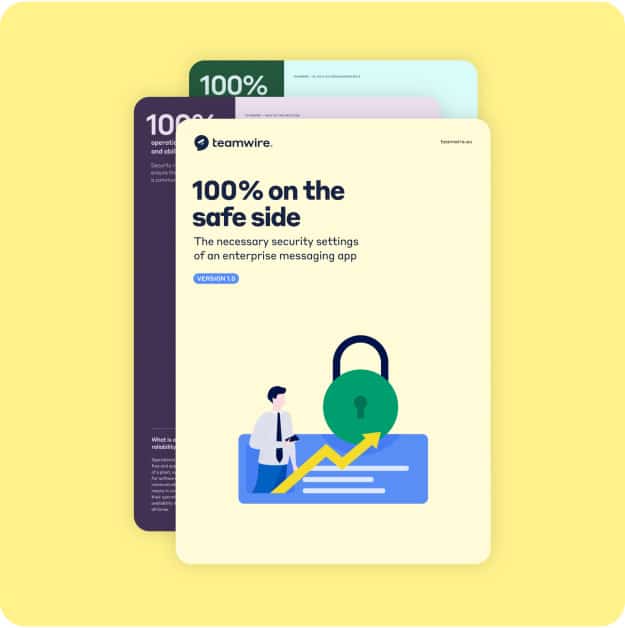There are many use cases and multiple productivity benefits by using an enterprise messenger for the internal communication. However, sometimes enterprises want to communicate with customers, partners, consultants or suppliers via the messenger as well. Since instant messaging is faster and more personal than email, and easier and more direct than phone calls, an enterprise messenger offers many advantages and use cases for the communication with customers and suppliers.
Some examples for an external communication are:
– Customer service wants to directly message customers to instantly solve issues.
– Sales wants to quickly exchange information with prospects via messaging to simplify the sales process.
– Management wants to discuss topics and projects with consultants and partners in group chats to get everybody involved.
– Procurement wants a fast communication channel with suppliers to coordinate purchases and deliveries.
– Marketing and PR need to easily coordinate campaigns and events with outside agencies.
– Advisors need direct and permanent chats with customers to ensure a closer and better relationship.
Teamwire regularly gets asked, how customers and suppliers can be connected with our enterprise messenger and what capabilities Teamwire offers for an external communication and messaging with external people.
Here are the 3 best options how to connect and message customers, partners and suppliers with our enterprise messenger:
1. Easy Connection with the “WhatsApp Method”
Enterprises that are hosted on the standard cloud of Teamwire can easily connect with external people with the “Whatsapp method” via the address book.
External people like customers and suppliers only have to download and install the Teamwire app. If the contact details (phone number or email) of employees of the enterprise are stored in address book, these users are automatically shown in Teamwire after the initial registration and synchronization steps. These users can then be selected as recipients for new 1:1 and group chats, can be invited to existing chats and enjoy the full functionality of Teamwire. Of course the same works for employees of the enterprise, who have stored external people in their address book.
The good thing is that the address book synchronization works in compliance with strong data protection and European law (e.g. GDPR). Before the synchronization the contact details in the address book like emails and a phone numbers get pseudonymized and one way encrypted, and after the synchronization even this data gets immediately deleted from the server. No address books of users and no related data get stored on the server of Teamwire.
Another advantage of this connection method is, that it does not connect external people with all employees of the enterprise automatically. External users like customers, suppliers and partners can only chat with the employees which they know and have stored in their address book.
The downside of this connection method is, that the external communication must be allowed for all employees in general. The IT administrator cannot grant access to selected external people only. Thus, there is little administrative control of the external communication ongoing and the chat archives of an enterprise are required to get full transparency on the messaging happening with external users like customers, suppliers and partners.
This method also works if the enterprise hosts Teamwire in a private cloud or on-premise infrastructure. However, the external contact then needs to know and enter the server URL during the registration.
2. Controlled Access with Personalized Emails
For enterprises that want more control over the communication with external people like customers and suppliers, personalized email identifiers are a good approach.
The enterprise configures a specific email for the external contact (e.g. john.smith@external.teamwire.eu) and invites this person via the administrator portal. The external person then registers for Teamwire with the given email and gets an authorized access to communicate with employees of the enterprise.
Depending how an IT administrator sets the communication rules and configures the user, the external person could chat with selected employees only or could message with all employees of the enterprise if required. It would also be possible for an administrator to configure specific policies for the external users, in order to restrict their access to content, to reduce the functionality of the app and to protect enterprise data.
The advantage of the connection method is, that it gives full administrative and access control of external users like customers, suppliers and partners: It allows to grant access of selected external people only. It gives full transparency, which external people communicate with the employees of the enterprise. It enables full control and configuration, who is allowed to communicate with whom. And if required, the access of the external people can be blocked anytime and even the app data on their devices could be wiped.
This method connection works for cloud, private cloud and on-premise deployments of Teamwire. Needless to say, no address book synchronization is required for this method. This can be an argument for security aware external users (even though an address book synchronization with Teamwire would be secure, protected and compliant).
3. Integration in Customer Apps and other Tools with Bots
Enterprises have often own apps and tools for customers, suppliers or partners, where they want to offer basic chat features, which enable these external people to quickly communicate with employees. This can be achieved with an integration of chat features of Teamwire into an enterprise app.
Teamwire provides an API that allows external apps, tools and services to connect to the Teamwire platform and use all messaging and sharing features. In general, the goal of such integrations is a digitalization, automation and acceleration of workflows. In this case, the integration has the goal to directly connect external people like customers, suppliers and partners with the employees of the enterprise, and enable a fast information exchange.
Let’s look at an example for such an integration: An enterprise integrates a basic chat window into its customer app for mobile devices. So basically the customer app gets a new chat feature. This chat gets connected to a bot that uses the API and platform of Teamwire. Instant messages written by customers in the app get automatically routed by the bot to the responsible employees of the enterprise, who use the Teamwire app. Employees can instantly reply, give direct feedback and easily send digital content via Teamwire to users of the customer app.
These kind of integrations are perfect for an easy connection and real-time messaging with customers, suppliers and partners. Such integrations extend the functionality of existing apps and tools, and improve the user experience. The real-time chats and quick feedback of employees increase customer satisfaction and strengthen the relationship with customers, partners and suppliers.
The advantage of such integrations is, that they allow comprehensive administrative and access control of external people like customers, suppliers and partners. It basically just depends on how an integration should work, how external users should be monitored, and what external people should be allowed to do. Then all this can be setup and configured.
While integrations and bots normally need to be developed (sometimes frameworks and/or components are available), often the effort and required resources are relatively low.
Contact Us for More Information
If you are interested to understand, how you can achieve the best connection, communication and instant messaging with external people like customers, partners and suppliers, how you can integrate chat components of Teamwire into your apps and tools, or want to find out more about our secure enterprise messenger, then please contact us.


